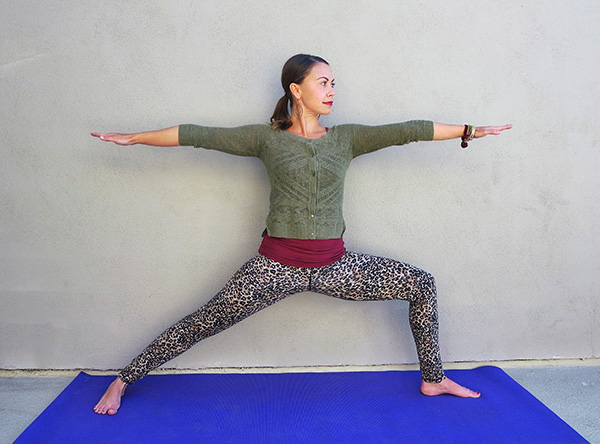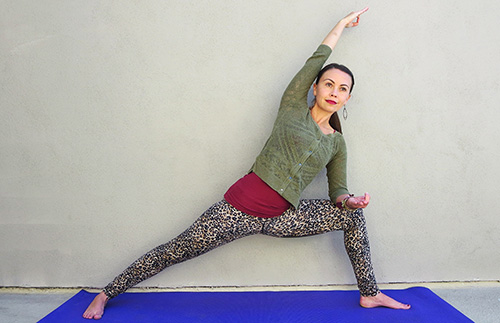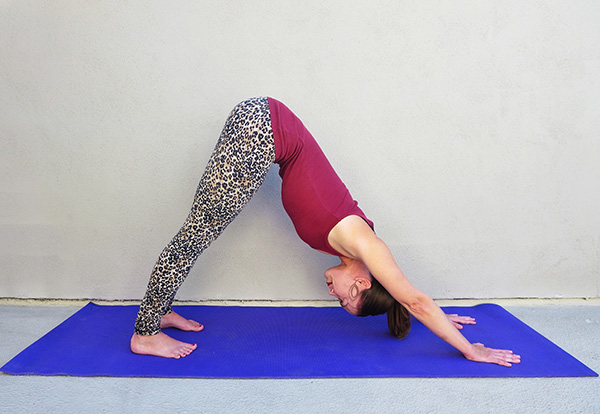Yoga’s benefits are impressive. It increases your range of motion, calms the mind, can relieve physical and emotional pain, reduces stress, and much more. But, if you’ve never tried it, it can also be intimidating. Whether you fall into that camp or you practice regularly, here are 8 common standing yoga poses for you to practice at home. They’ll not only improve your posture, they’ll also help you strengthen your arms, core, shoulders, and legs.
Mountain Pose (Tadasana)
It doesn’t look like much, but Mountain Pose is a starting position for many other standing yoga poses. Stand with your big toes touching, heels slightly apart. If you find it hard to balance, separate your feet slightly, then flex the quadriceps and rotate the thigh muscles inward, opening up the sit bones and your lower back. Engage your core and tuck in your tailbone. Finish by expanding your chest by pulling your shoulders back and down, lengthening your neck, and tucking your chin in slightly.

It doesn’t look like much, but Mountain Pose is a starting position for many other standing yoga poses. Stand with your big toes touching, heels slightly apart. If you find it hard to balance, separate your feet slightly, then flex the quadriceps and rotate the thigh muscles inward, opening up the sit bones and your lower back. Engage your core and tuck in your tailbone. Finish by expanding your chest by pulling your shoulders back and down, lengthening your neck, and tucking your chin in slightly.

Standing Forward Bend (Uttanasana)
The forward bend is a very natural transition from Mountain Pose and an easy standing yoga pose for beginners. Begin with your feet hip-distance apart. Hinge forward from your hips, keeping your spine straight, and bring your torso toward your legs. Reach your arms toward the floor, and let your head hang. If you’re finding this pose difficult, bend your knees slightly. To intensify it, wrap your arms around your legs and pull your chest closer to your thighs. The Standing Forward Bend strengthens your knees, thighs, and core and may help relieve pain in the hamstrings, lower back, and hips.

The forward bend is a very natural transition from Mountain Pose and an easy standing yoga pose for beginners. Begin with your feet hip-distance apart. Hinge forward from your hips, keeping your spine straight, and bring your torso toward your legs. Reach your arms toward the floor, and let your head hang. If you’re finding this pose difficult, bend your knees slightly. To intensify it, wrap your arms around your legs and pull your chest closer to your thighs. The Standing Forward Bend strengthens your knees, thighs, and core and may help relieve pain in the hamstrings, lower back, and hips.

Warrior II (Virabhadrasana II)
Warrior II strengthens and stretches the body at the same time, giving you the feeling of a strong, fierce warrior. Assume a wide stance, with the toes of the back right foot pointed at 45 degrees so it aims towards the top right corner of the mat. Set your left foot parallel with the short side of the mat. Keeping your right leg straight, bend your left knee so that it is parallel with the left ankle and press firmly on the outside edge of the right foot. Tuck in your tailbone, align your shoulders with your hips, and reach your arms out so that they’re parallel with the floor. Your shoulders should be relaxed and pulled away from your ears. Finally, lengthen your neck and gaze out over your left arm. Repeat on the other side. This pose strengthens your ankles, legs, glutes, core, and back.

Warrior II strengthens and stretches the body at the same time, giving you the feeling of a strong, fierce warrior. Assume a wide stance, with the toes of the back right foot pointed at 45 degrees so it aims towards the top right corner of the mat. Set your left foot parallel with the short side of the mat. Keeping your right leg straight, bend your left knee so that it is parallel with the left ankle and press firmly on the outside edge of the right foot. Tuck in your tailbone, align your shoulders with your hips, and reach your arms out so that they’re parallel with the floor. Your shoulders should be relaxed and pulled away from your ears. Finally, lengthen your neck and gaze out over your left arm. Repeat on the other side. This pose strengthens your ankles, legs, glutes, core, and back.

Tree Pose (Vrksasana)
Weight-bearing exercises help build strong bones and the Tree Pose is no exception. This standing yoga pose is also a way to ease in to more complicated balancing poses. To begin, start in Mountain Pose with your feet hip-distance apart. Keeping your hands at your hips, slowly raise, then press the sole of the right foot into your left calf muscle or left inner thigh, taking care to not press it into the knee. To help you balance, press your foot into your leg and your leg into your foot. Once you feel stable, you can can press your hands together in front of your chest, raise them above your head, or stretch them out to the sides. This pose also helps strengthen the ankles, calves, quadriceps, thighs, glutes, and core.

Weight-bearing exercises help build strong bones and the Tree Pose is no exception. This standing yoga pose is also a way to ease in to more complicated balancing poses. To begin, start in Mountain Pose with your feet hip-distance apart. Keeping your hands at your hips, slowly raise, then press the sole of the right foot into your left calf muscle or left inner thigh, taking care to not press it into the knee. To help you balance, press your foot into your leg and your leg into your foot. Once you feel stable, you can can press your hands together in front of your chest, raise them above your head, or stretch them out to the sides. This pose also helps strengthen the ankles, calves, quadriceps, thighs, glutes, and core.

Reverse Warrior (Viparita Virabhadrasana)
This pose has all the benefits of Warrior II, plus an added stretch for the spine. To perform it, assume the Warrior II position with your left leg forward, reach your right arm toward the back of the mat, running your hand down the outside edge of your straight right leg. Reach your left arm up and over the head, without bending your elbow, and stretch the neck by looking back and down at the floor behind you. Repeat on the other side.

This pose has all the benefits of Warrior II, plus an added stretch for the spine. To perform it, assume the Warrior II position with your left leg forward, reach your right arm toward the back of the mat, running your hand down the outside edge of your straight right leg. Reach your left arm up and over the head, without bending your elbow, and stretch the neck by looking back and down at the floor behind you. Repeat on the other side.

Extended Side Angle (Utthita Parsvakonasana)
Extended Side Angle is similar to Reverse Warrior, but it stretches the other side of the body, making it a good transition from Reverse Warrior. Assume the Warrior II position with your left leg forward, then fold your upper torso toward your bent leg and rest your left elbow on your left quad, palm up. Reach the right arm directly over your head without bending the elbow. Sink deep into the left hip so you can create a straight line from the outer edge of the right foot to the right fingertips. This standing yoga pose does an excellent job at strengthening the calves, quads, hamstrings, and groin and stretching the legs, hips, spine, waist, chest, shoulders, and arms.

Extended Side Angle is similar to Reverse Warrior, but it stretches the other side of the body, making it a good transition from Reverse Warrior. Assume the Warrior II position with your left leg forward, then fold your upper torso toward your bent leg and rest your left elbow on your left quad, palm up. Reach the right arm directly over your head without bending the elbow. Sink deep into the left hip so you can create a straight line from the outer edge of the right foot to the right fingertips. This standing yoga pose does an excellent job at strengthening the calves, quads, hamstrings, and groin and stretching the legs, hips, spine, waist, chest, shoulders, and arms.

Triangle Pose (Utthita Trikonasana)
Triangle Pose looks easy, but if you have tight hamstrings or hips, you may find it challenging. That doesn’t mean it’s not for beginners. It just may take some time to perfect. Begin in Warrior II with your left foot forward. Straighten your left leg and reach your arms out in a T formation. Keeping your arms parallel to each other, bend toward the inside of the front leg until your fingertips reach the ground. Rotate your right shoulder up and back and reach for the sky, turning your gaze upward along the right arm or to the floor for balance.
Note: If you’re feeling inflexible, place a block under your hand to take the pressure off of your hips and leg.

Triangle Pose looks easy, but if you have tight hamstrings or hips, you may find it challenging. That doesn’t mean it’s not for beginners. It just may take some time to perfect. Begin in Warrior II with your left foot forward. Straighten your left leg and reach your arms out in a T formation. Keeping your arms parallel to each other, bend toward the inside of the front leg until your fingertips reach the ground. Rotate your right shoulder up and back and reach for the sky, turning your gaze upward along the right arm or to the floor for balance.
Note: If you’re feeling inflexible, place a block under your hand to take the pressure off of your hips and leg.

Downward Dog (Adho Mukha Svanasana)
This classic pose is one of the first that many new to yoga learn. It’s also great for stretching out the calves post-workout. Begin on your hands and knees, with shoulders over wrists and hips over knees. Spread your palms and press your hands into the floor. Press into your hands, lift your knees, and push yourself up and back. Lift your bottom high to the sky and straighten your legs as you rotate your straightened arms outward and draw your shoulders away from your ears. Let your head hang and rotate your thighs inward, opening up your sit bones. Work your heels toward the floor until they eventually touch the ground. This pose strengthens and stretches the whole body, particularly legs, arms, hands, feet, core, chest, and back.
This classic pose is one of the first that many new to yoga learn. It’s also great for stretching out the calves post-workout. Begin on your hands and knees, with shoulders over wrists and hips over knees. Spread your palms and press your hands into the floor. Press into your hands, lift your knees, and push yourself up and back. Lift your bottom high to the sky and straighten your legs as you rotate your straightened arms outward and draw your shoulders away from your ears. Let your head hang and rotate your thighs inward, opening up your sit bones. Work your heels toward the floor until they eventually touch the ground. This pose strengthens and stretches the whole body, particularly legs, arms, hands, feet, core, chest, and back.

Photos by Lulu Lam
Author: Sarah Stevenson
No comments:
Post a Comment